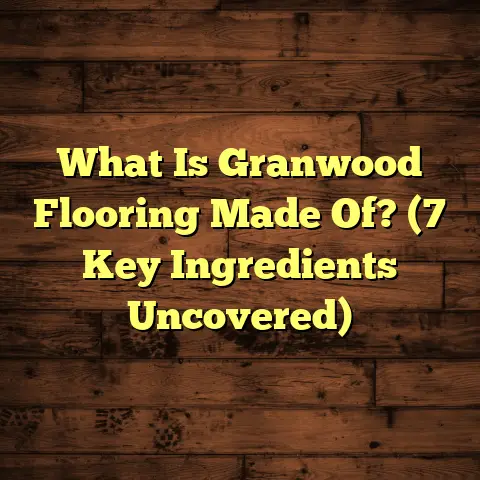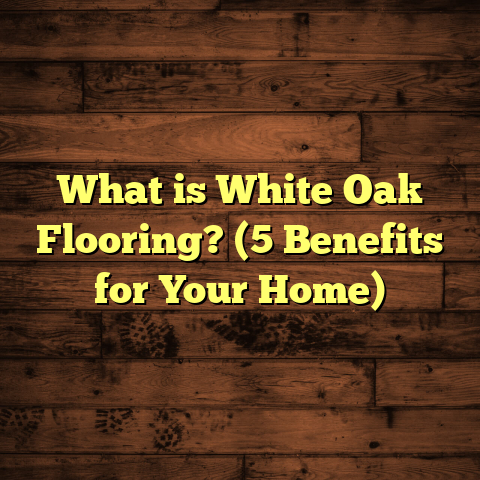What is the Price of Red Oak Flooring? (5 Factors to Consider)
Have you ever imagined walking barefoot on a floor that feels warm, natural, and timeless? Maybe you’ve admired the rich, reddish hues of red oak flooring in stylish homes or boutique hotels and wondered if it could transform your space too. But then, the big question hits: “What’s the price of red oak flooring?” I’ve been helping homeowners and contractors get clear answers to this very question for years. Let me share what I’ve learned, including my personal experiences, data-backed insights, and tips to help you make the best decision for your home.
What Is Red Oak Flooring?
Red oak flooring is a type of solid hardwood flooring made from the wood of the red oak tree (Quercus rubra), which is widely found across North America. It’s one of the most popular hardwood species used for flooring due to its combination of durability, beauty, and affordability.
The appeal of red oak lies in its distinctive grain patterns and warm colors. The wood features a coarse texture with open pores and rays that create attractive flecks on the surface when finished. Its natural color ranges from a soft pinkish to a deeper reddish-brown tone, giving it that classic “red oak” look that many love.
Compared to other hardwoods like maple or hickory, red oak is relatively easy to work with because it’s not too hard or brittle. It can be nailed, glued, or stapled down, making installation flexible. Plus, it sands and finishes well, which means you can refinish your floors multiple times over their lifetime.
When I first started installing red oak floors over a decade ago, I was immediately drawn to how well it balances toughness with aesthetic appeal. Many clients have told me their red oak floors become a conversation piece in their homes — guests often comment on how inviting and natural they feel.
What Makes Red Oak So Popular?
- Durability: Red oak has a Janka hardness rating of about 1,290, which makes it durable enough for everyday use in busy households.
- Versatility: It accepts stains very well, so you can customize the color from light blondes to deep mahogany tones.
- Affordability: It tends to be more affordable than exotic hardwoods while still offering excellent quality.
- Availability: Being native to North America means it’s easier to source fresh materials compared to imported woods.
Breaking Down the Price of Red Oak Flooring: Five Key Factors
Now that you know what red oak flooring is, let’s talk about what impacts its price. I’ve seen plenty of projects where costs varied widely even though the flooring type was the same. Here’s why.
1. Wood Grade: Quality Matters (And Price Does Too)
Wood grade essentially defines how “perfect” or “character-filled” your planks will be. You might think all red oak looks similar once installed, but grade differences can change the look dramatically — and your budget too.
- Select or Clear Grade: This is premium wood with minimal knots or imperfections. It results in smooth, uniform planks that showcase the wood’s natural beauty without distractions. This grade typically costs between $7 and $9 per square foot just for materials.
- Common or Character Grade: This grade includes more knots, mineral streaks, and color variations that give the floor rustic charm and personality. It is less expensive—usually around $4 to $6 per square foot—but the appearance is more varied.
- Prime Grade: Falls between select and common grades in both look and price.
In one project I handled for a young couple wanting clean lines in their mid-century modern home, we opted for select-grade prefinished red oak. The natural wood had very few knots, which perfectly suited their minimalist design. This choice added about $3 per square foot compared to common grade but was worth it for the look they wanted.
On the other hand, a family wanting a cozy cabin vibe chose common-grade red oak with visible knots and color variations. They loved the character it added and saved about 30% on materials.
Tip: If you want that flawless look but are on a budget, consider select grade for main living areas and common grade in less visible rooms.
2. Finish Type: Prefinished vs Unfinished Floors
Another major cost factor is whether you choose prefinished or unfinished red oak flooring.
- Prefinished Flooring: These planks come factory-finished with multiple coats of durable polyurethane or aluminum oxide. They’re ready to install right out of the box. Prefinished floors reduce installation time since no sanding or finishing is needed onsite.
- Unfinished Flooring: These come raw and require sanding, staining, and sealing after installation. While this gives you total control over stain color and finish type, it adds labor time and cost.
From my experience, most homeowners prefer prefinished floors because they’re quicker and cleaner to install. Prefinished red oak usually costs between $5 and $9 per square foot for materials alone.
Unfinished options cost less upfront ($4-$7 per square foot) but add about $3-$5 per square foot for finishing labor. So total cost ends up similar or slightly higher.
I remember one project where the homeowner wanted a unique stain color matching old family floors. We went with unfinished red oak so they could do custom staining onsite. The process took longer and involved more cleanup but delivered exactly the color they wanted. They told me afterward they were happy with the extra effort despite paying around 15% more in labor.
In my opinion, if you want speed and convenience plus consistent factory finishes, prefinished is best. But if you want customization and don’t mind extra work or mess, go unfinished.
3. Installation Method: How You Lay Your Floor Changes Cost
The installation method also influences pricing because some methods take more time or materials:
- Nail-down Installation: The traditional method for solid red oak floors over wood subfloors. Nails anchor each plank securely but require precise work.
- Staple-down Installation: Similar to nail-down but uses staples instead of nails. It’s faster but requires compatible tools.
- Glue-down Installation: Often used when installing engineered red oak over concrete slabs or radiant heating systems. Glue adds cost for adhesive materials and prep.
- Floating Floors: Less common with solid red oak but possible with engineered products that click together without nails or glue.
Nail-down installation usually costs between $3-$5 per square foot in labor depending on complexity.
Glue-down methods tend to be pricier due to adhesive costs and extra labor—about $4-$6 per square foot.
I once installed nail-down red oak floors in an older home with uneven plywood subfloors. We had to spend extra time leveling surfaces before installation, which added about $1 per square foot in labor costs.
4. Location & Labor Market: Where You Live Makes a Difference
Labor costs for installation vary widely by region due to differences in living expenses and contractor availability.
I’ve worked in small rural towns where labor charges were as low as $2 per square foot for installation. In bigger cities like New York or San Francisco, those rates easily hit $6+ per square foot.
Also, some contractors set minimum fees regardless of project size. So if you’re only doing one room (say 200 sq.ft), expect to pay a minimum charge that can raise your effective price per square foot.
I always advise clients to get multiple quotes from local installers because prices can swing dramatically even within the same city.
5. Additional Materials & Waste Factor: Don’t Forget These Extras
Beyond wood planks and labor, there are other materials needed such as:
- Underlayment or vapor barriers
- Transition strips between rooms or floor types
- Baseboards or quarter-round moldings
- Adhesives if required for glue-down installations
Plus, installers typically order 5-10% extra material to account for waste caused by cutting irregular shapes around walls, doorways, or mistakes during installation.
I had one customer who ordered exactly 1,000 sq.ft for their project without waste allowance. Midway through installation we realized additional planks were needed due to angled cuts around stairwells. Ordering more planks later delayed completion by several days.
Always budget for these extras — they usually add 5-15% to your overall material cost.
My Personal Stories With Red Oak Flooring Projects
Story 1: The Busy Family Home
A few years ago I worked with a family who wanted durable flooring throughout their 2,000-square-foot home. They had three kids under 10 and two large dogs — so durability was top priority. They chose prefinished select-grade red oak with a strong aluminum oxide finish for scratch resistance.
The project went smoothly except we ran into unexpected moisture issues under the kitchen subfloor causing some planks to warp after two months. We had to pull up sections and replace plywood underlayment plus install a moisture barrier before reinstalling the floor — adding roughly $1,200 in costs.
This experience taught me how important it is to inspect subfloors carefully before installing hardwoods in older homes with potential moisture problems.
Story 2: The DIY Stain Project
I also remember helping a couple who wanted that rustic charm only common-grade unfinished red oak could provide. They bought raw planks and stained them themselves as a weekend project.
Though it took longer than expected (and made quite a mess!), they loved personalizing their floors with custom colors that matched their furniture perfectly. Their total cost was about 20% less than prefinished options because they saved on factory finishing fees.
What Does Research Tell Us?
According to industry data from sources such as the National Wood Flooring Association (NWFA) and home improvement market reports:
- Average material costs for red oak flooring range from $4 to $9 per square foot.
- Installation labor averages $3 to $6 per square foot nationwide.
- Total installed costs generally fall between $7 and $15 per square foot.
- Premium grades and custom staining can add up to 40% more than basic options.
- Urban areas report up to 30% higher labor costs compared to rural regions.
A case study from a flooring company showed customers who selected select-grade prefinished red oak spent an average of $12 per square foot installed versus $8 for common-grade options.
What Are Common Challenges With Red Oak Flooring?
While red oak is fantastic overall, there are some challenges you should know about:
- Moisture Sensitivity: Like all hardwoods, red oak expands and contracts with humidity changes. Improper moisture control can cause warping or cupping.
- Scratch Resistance: Though durable, red oak isn’t as hard as some exotic woods like Brazilian cherry or hickory. Heavy furniture or pet claws can leave marks over time.
- Color Variation: Especially with common grades, color inconsistencies can be noticeable—some people love this rustic look; others don’t.
- Installation Complexity: Older homes may need subfloor repairs or moisture barriers before hardwood goes down.
I’ve seen projects delayed because homeowners didn’t account for moisture testing or subfloor prep upfront — adding weeks and thousands of dollars unexpectedly.
Maintenance Tips To Protect Your Investment
To keep your red oak floor looking great for decades:
- Use felt pads under furniture legs.
- Clean spills promptly.
- Avoid harsh chemical cleaners; use products designed for hardwood.
- Maintain indoor humidity between 35%-55% to reduce expansion/contraction.
- Refinish every 7-10 years depending on wear patterns.
How To Budget For Your Red Oak Flooring Project
Here’s a simple budgeting checklist based on my experience:
| Item | Estimated Cost (per sq.ft) |
|---|---|
| Red Oak Wood (Materials) | $4 – $9 |
| Finish (if unfinished) | $3 – $5 (labor) |
| Installation Labor | $3 – $6 |
| Additional Materials | $0.50 – $2 |
| Waste Allowance | Add 5%-10% extra wood |
Multiply this by your total square footage plus add about 10%-15% contingency for unexpected expenses like subfloor repairs or moisture mitigation.
Final Thoughts
If you want warm, beautiful hardwood floors that stand up to daily life while adding timeless value to your home — red oak is an excellent choice. Your final price depends on wood grade, finish type, installation method, location labor costs, and extras like moldings or waste material.
From my years installing red oak floors in all kinds of homes — from cozy cottages to large family houses — I’ve learned that planning carefully upfront saves money and headaches later. Ask lots of questions from your installer about subfloor prep and moisture control before ordering materials.
Are you thinking about tackling this project soon? Or maybe you want tips on finding reliable local installers? Feel free to ask — I’m here to help you get that perfect floor without surprises!
If you want me to help calculate an estimated cost tailored specifically for your home size and location using tools like FloorTally or share more stories about different finishes and designs I’ve worked on — just say so!





